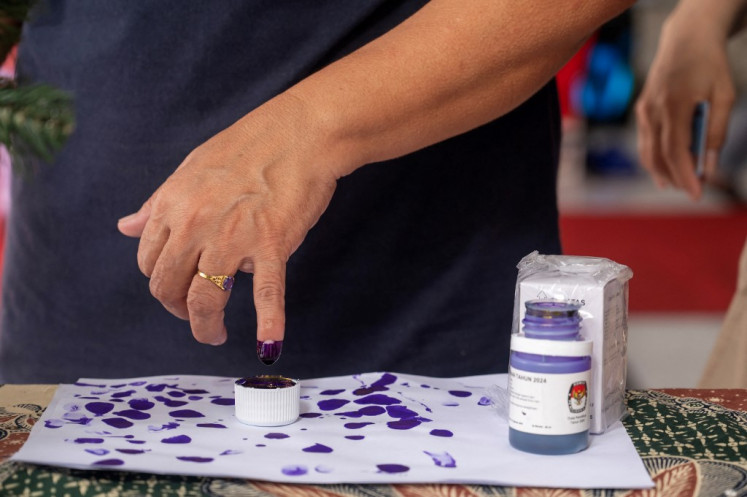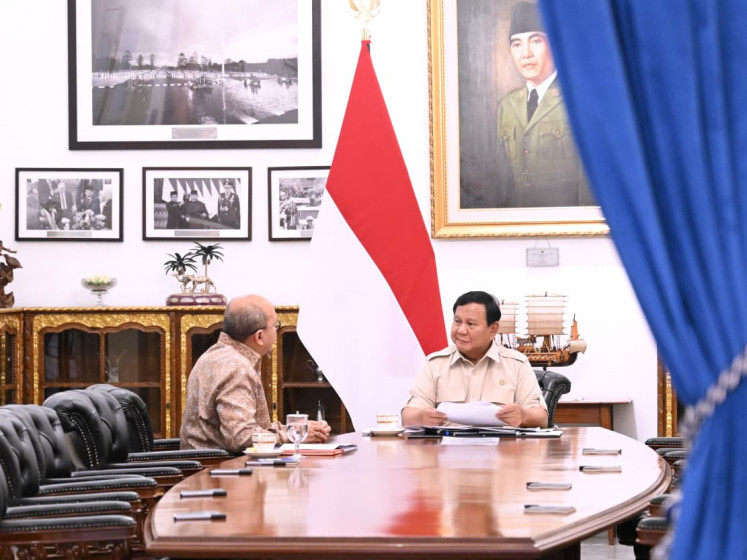Popular Reads
Top Results
Can't find what you're looking for?
View all search resultsPopular Reads
Top Results
Can't find what you're looking for?
View all search resultsSocial protection becomes digitally integrated
Narsih, a 40-year-old housewife from Sidoarjo, East Java, spent more than 5 minutes in front of an ATM set up inside the main hall of the Sidoarjo regency building
Change text size
Gift Premium Articles
to Anyone
N
arsih, a 40-year-old housewife from Sidoarjo, East Java, spent more than 5 minutes in front of an ATM set up inside the main hall of the Sidoarjo regency building. She was trying to withdraw her social assistance fund, disbursed by the Social Affairs Ministry under its Family Hope Program (PKH), from the ATM.
Narsih is among the first recipients of the non-cash social assistance fund from the ministry, which selected 350 low-income families in Sidoarjo and 30 families in Malang, East Java. The scene marks a monumental shift in the country’s long fight against poverty, where over 80 percent of the population lives on less than Rp 32,000 (US$2.40) per day.
Usually, the government disburses social assistance funds to poor families by cash through post offices or local banks. But in most cases, the recipients of the financial aid will spend all of their money right after receiving it as a culture of saving is still uncommon among low-income families.
“They usually save their money under their pillows. But usually this kind of saving will not last because there is a psychological effect of using money if the money can be seen,” the Social Ministry’s social protection and insurance director general, Harry Hikmat, told The Jakarta Post.
Therefore, the government has recently started to channel aid directly to the recipients’ savings or virtual accounts to increase recipients’ saving habits and thus improve their welfare.
But the ultimate goal of shifting from cash to non-cash social assistance is to build an inclusive social protection system that ensures no one is left behind. Along with the shift to non-cash social assistance, the government is moving toward a unified social protection system, where the poor is guaranteed to receive the complete social protection-program package.
Right now, the government’s social protection programs are scattered, such as the Indonesia Smart Program (PIP), the National Health Insurance (JKN) program and the PKH.
“On average, 20 percent [of the recipients] are still not connected because the targeting system of the PKH, PIP and the JKN are not integrated yet. The Social Ministry is working on integrating them through a social register-integrated system in cooperation with the World Bank,” Harry said.
Currently, the country’s poverty-targeting system generates high inclusion and exclusion errors, and because of its complexity, is expensive to administer.
“Until now, there are still many poor families because the social protection programs are not complete yet. In some regions, there are people who have received social assistance funds but are denied when they ask for the PIP program. The poorer a family is, the more complete the social protection package should be,” Harry said.
In the future, all social protection programs, which are currently being managed by different government institutions, will have a single database, according to him.
With a complete and integrated social-protection program, the ministry aims to reach 9 million low-income families and reduce the poverty rate to 9.3 percent by 2019 from the current rate of 10.8 percent, the lowest level in at least 20 years. Out of the 9 million recipients, the ministry plans to distribute non-cash aid to 2 million of them.
Currently, the ministry is mulling several options to distribute non-cash aid, including through bank accounts, SIM cards and e-vouchers. However, Harry acknowledged that the shift to non-cash aid would face some challenges from the recipients, such as lack of knowledge on how to use an ATM.
Likewise, Social Affairs Minister Khofifah Indar Parawansa said eventually the recipients of social aid would have to be tech-savvy as the government gradually was shifting to non-cash aid.










